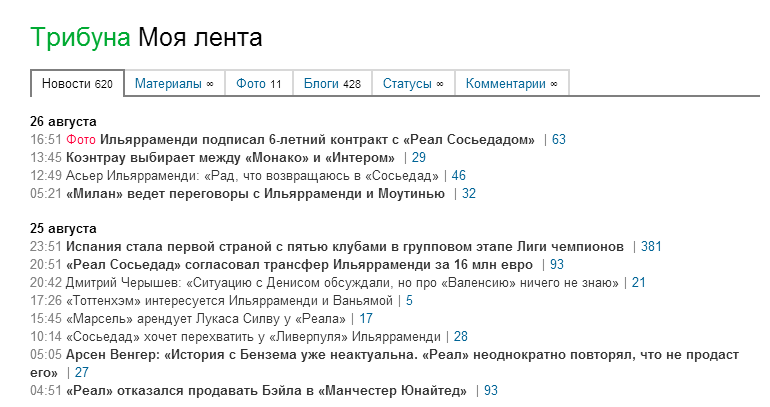Purely technically: How the media becomes more interesting with the help of developers

We have collected examples of how media attracts an audience using mathematical algorithms, robots, and other purely technical gadgets.
To each his own
Media wins extra points if adjusted to the user.
')
People often read the media for certain headings or sections. We now like “Opinions” in “Vedomosti” (And the news can be read on other sites.) The New York Times made a feature for such a case: the newspaper allows you to subscribe to individual headings, and sends updates by e-mail. (Mailing lists, in general, remain undervalued in the Russian media.)
The publication FirveThirtyEight in the DataLab section allows you to filter content by topic and collects it into one tape.

On Sports.ru you can personalize the ribbon by analogy with social networks. After logging in, you subscribe to blogs and sources of interest - get a feed with personalized news, texts and photos.

Recommendations are another way to make media more convenient. When the user has read the article, offer another in accordance with his interests. So the user remains on the site longer.
Ria.ru shows the Relap widget for materials, where mathematical algorithms are personalized to select articles.

When RIA began to use the recommendations, the CTR of the block “Main Today” rose from 12 to 25%, and the session duration increased 79 seconds to 3 minutes.
Interactivity and responsiveness
Information media has an eternal background dilemma. You write a short update - readers may not understand what happened. You write all the backstory - you go crazy. The Washington Post embeds interactive footnotes in texts. You do not know how IG recruits people? - click and read the sidebar explanation or other materials on the topic. Do you recruit soldiers? - read on.

Everyone loves longrida - large detailed texts with a non-standard layout. Even if you do not have your own cool admin panel, you can collect a good longrid on "Tilde" or in "Redimag".
Sweetie:
Vox Media posted the AutoTune tool code on GitHub - with its help, journalists create graphs, slideshows, tests and other interactive materials. Everything is done on the basis of templates.
Lasertag is a WordPress plugin developed on the Al-Jazeera hackathon, which itself selects relevant links to the highlighted words. (For those who are too lazy to link.)
Robots
The New York Times love robots. Every day the publication publishes more than 300 materials on the site, and about 50 get into social networks. In order to select articles for publication, the robot Blossom has appeared. He lives in the Slack Messenger. The journalist asks "Blossom Facebook?", And the robot advises the material for publication.

Blossom analyzes how people react to articles and constantly learns. Preliminary results show that the materials Blossom selected for publication collect 120% more clicks.
The New York Times also has the Editor robot, which helps tag the materials. (There are so many of them that no editor can select them correctly.)
Now in the course of services that are looking for geolocation photos published on Instagram. Long before the idea went to the people, TJ created one. They use it for reportage and heading "Place on Instagram." Each issue collects at least 10 thousand views.
When TJ was just launched, as an aggregator of the most interesting news discussed in Runet, a robot was created that analyzes the media and Russian-language Twitter. Such tools are convenient for both site visitors and journalists: all important sources are collected in one place, and materials are ranked by popularity in social networks or by chronology.

Admin panel
“I would choose a tool to create Snow Fall, not Snow Fall itself,” says Quartz editor Kevin Delaney. Media is important to get not cool special project, and technology that will allow you to create them every day.
The publication wos.ru is famous for its non-standard layout of materials. To repeat it in one of the popular CMS would be problematic. Initially, each material was typed from scratch, but at the end of 2014, the edition re-launched on a self-hosted CMS and even offered to try out its new admin panel to anyone.

Vox Media Publishing House, which manages The Verge, Polygon and Re / Code, to launch a completely new media in 2014, based on its own platform, Chorus. So the Vox site from scratch was created in 9 weeks.
Source: https://habr.com/ru/post/294252/
All Articles